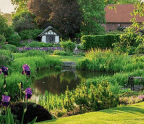
Tucked off a tiny Norfolk lane is a nature reserve known as Snowdrop Acre. Cared for by a local conservation group, this pocket of land’s obscure connection to snowdrop royalty, one Heyrick Greatorex, will be known to only the most ardent galanthophile. But you don’t need to be a galanthophile for the name ‘Greatorex’ to ring a bell.
The term Greatorex doubles, referring to the array of double-flowered snowdrops bred by this gentleman and former corporal, will be familiar to many of us, even if we only dabble in these early spring bulbs. Crossing the common double form of Galanthus nivalis, ‘Flore Pleno’, with G. plicatus, Greatorex created a range of hybrid doubles that were tall, large-flowered and quite the sensation at the time. Many were named after Shakespearean heroines: ‘Lavinia’, ‘Cordelia’, and ‘Jacquenetta’ to name but a few.






